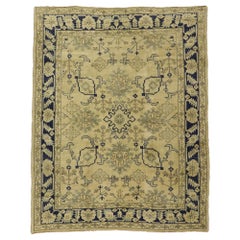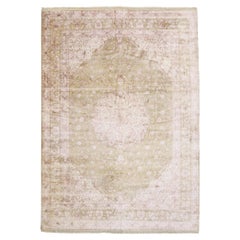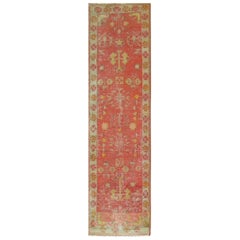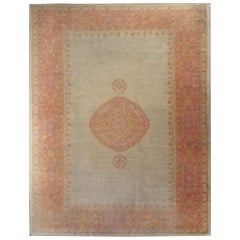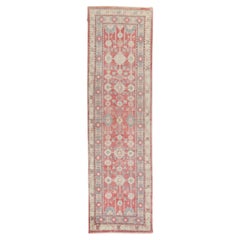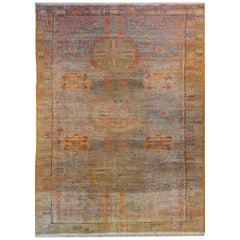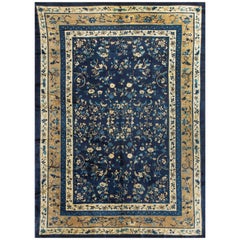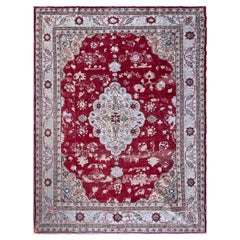Oushak Chinese and East Asian Rugs
Turkish rugs are as widely loved today as they were in the 13th century, and antique and vintage Oushak rugs and carpets are known specifically for their bold geometric patterns and fine quality. With a name derived from the town of Uşak, Turkey, in western Anatolia, the Oushak textile style — also spelled Ushak — originated in the 15th-century Ottoman Empire, but its aesthetic has influenced weaving around the world, especially through the export of rugs to Europe.
The distinctive Oushak “medallion” pattern has two types of rounded shapes alternating against a rich red or blue background created with natural dyes, while the elaborate “star” pattern involves large eight-pointed shapes in diagonal rows alternating with diamonds. Traditionally, the edges and empty spaces are filled with arabesque details or floral motifs. Both patterns can repeat in infinite directions, allowing for versatility in diverse sizes of hand-knotted authentic Oushak carpets, wall hangings and rugs. It’s believed that similar Iranian designs inspired the artistry of Turkish weavers, possibly through commissions by Sultan Mehmed the Conqueror.
While production of Oushak rugs accelerated for an international audience, they also maintained domestic popularity, including covering the floors of palaces and mosques. Owing to their deep colors and exemplary construction, Oushak area rugs woven by hand became status symbols abroad, with Henry VIII depicted standing astride an Oushak rug in a 16th-century portrait by Hans Holbein the Younger. The rugs and carpets made for export had rougher weaves while European copies proliferated as demand expanded into the 19th century. And beyond the authenticity of antique and vintage rugs in general, the geometric styles of Oushak rugs are appealing to interior designers because they work so well in today's homes.
The market has changed with a global increase in machine-fabricated carpets, yet handmade designs continue to be produced in Uşak with contemporary rug companies like Kirkit working with skilled artisans in the area.
Find vintage Oushak rugs and carpets, folk art and other Oushak furniture on 1stDibs.
Mid-20th Century Turkish Oushak Chinese and East Asian Rugs
Wool
Late 20th Century Turkish Oushak Chinese and East Asian Rugs
Silk
Late 19th Century East Turkestani Antique Oushak Chinese and East Asian Rugs
Wool
Late 19th Century Antique Oushak Chinese and East Asian Rugs
Wool
20th Century East Turkestani Oushak Chinese and East Asian Rugs
Wool
Early 20th Century Turkmen Oushak Chinese and East Asian Rugs
Wool
Mid-20th Century Turkish Oushak Chinese and East Asian Rugs
Wool
2010s Chinese Oushak Chinese and East Asian Rugs
Silk
21st Century and Contemporary Pakistani Oushak Chinese and East Asian Rugs
Wool
1930s Central Asian Vintage Oushak Chinese and East Asian Rugs
Wool
Early 20th Century Chinese Oushak Chinese and East Asian Rugs
Wool
20th Century Turkish Oushak Chinese and East Asian Rugs
Silk
Late 20th Century Turkish Oushak Chinese and East Asian Rugs
Silk
20th Century Turkish Oushak Chinese and East Asian Rugs
Wool
Mid-20th Century Chinese Oushak Chinese and East Asian Rugs
Wool
1920s Chinese Vintage Oushak Chinese and East Asian Rugs
Wool, Cotton
2010s Turkish Oushak Chinese and East Asian Rugs
Wool
2010s Turkish Oushak Chinese and East Asian Rugs
Wool
Mid-19th Century East Turkestani Antique Oushak Chinese and East Asian Rugs
Wool
1960s Chinese Vintage Oushak Chinese and East Asian Rugs
Wool
Early 20th Century Turkmen Oushak Chinese and East Asian Rugs
Wool
2010s Nepalese Oushak Chinese and East Asian Rugs
Wool, Silk
20th Century Turkish Oushak Chinese and East Asian Rugs
Wool
Early 1900s Persian Antique Oushak Chinese and East Asian Rugs
Wool
Early 20th Century East Turkestani Oushak Chinese and East Asian Rugs
Wool
Early 20th Century East Turkestani Oushak Chinese and East Asian Rugs
Wool
